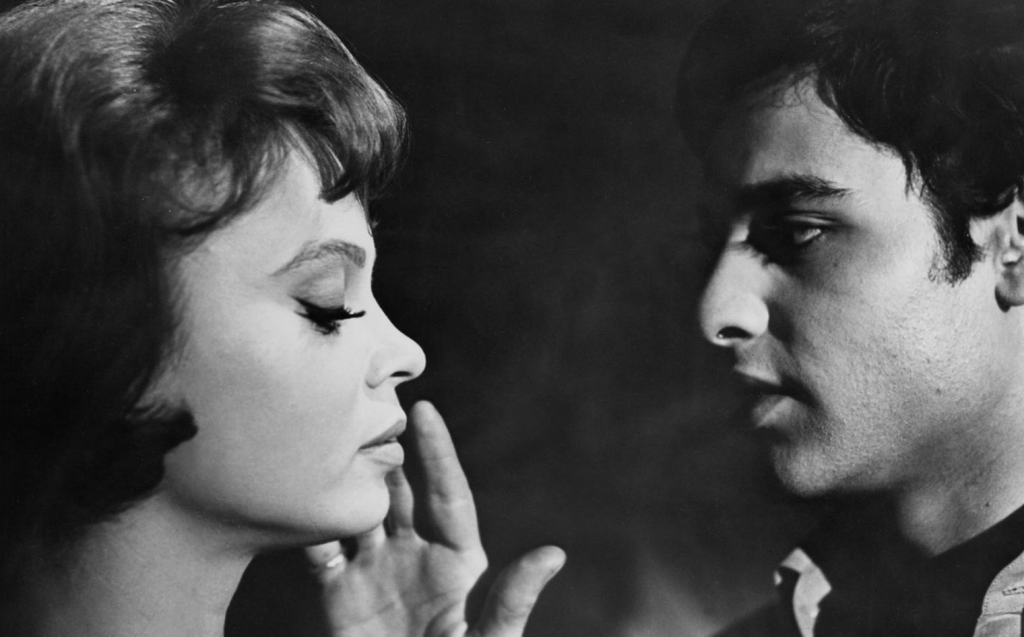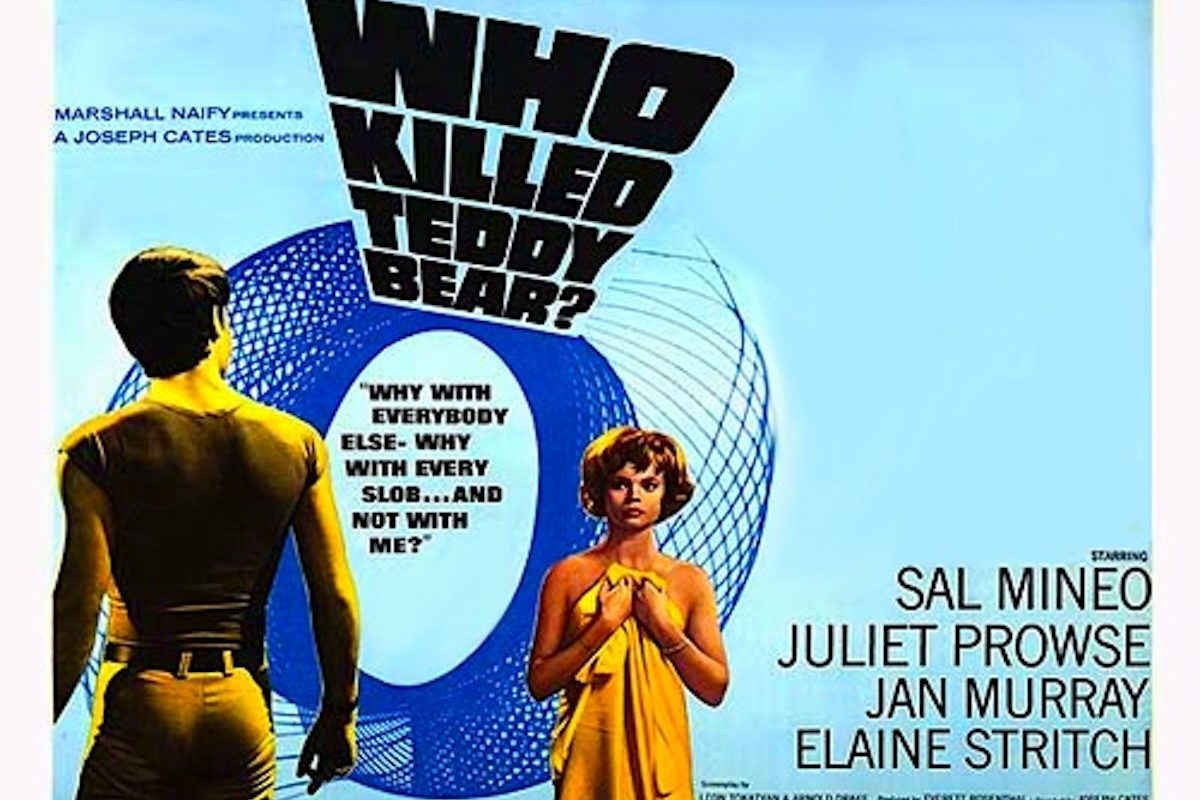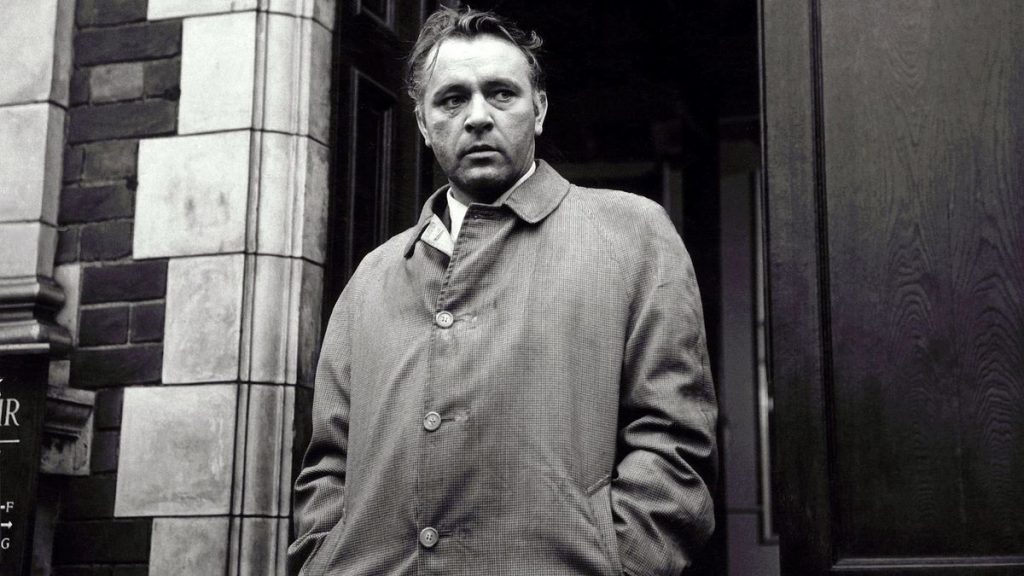Plenty of films have been described as ‘ahead of their time.’ Rarer are those that capture the exact moment in time when everything starts to change. Released 60 years ago, smack dab in the middle of the 1960s, Who Killed Teddy Bear? is just such a film.
Helmed by veteran television director and producer Joseph Cates, from a script by Leon Tokatyan and Arnold Drake (a comic book scribe who would go on to create The Guardians of the Galaxy), Who Killed Teddy Bear? is an amalgamation as odd as the deviants that make up its cast of characters, an independently-produced psycho-sexual neo-noir exploitation picture that oscillates between gritty docudrama and Grand Guignol camp. It is equal parts harsh and empathetic, pedantic and surreal, comic and frightening, morally hysterical and deeply perverse.
It is also a showcase for its star, the late, great Sal Mineo. A two-time Oscar nominee best known for his iconic turn as doomed teenager Plato in 1955’s Rebel Without a Cause. But ten years after that performance his star had faded considerably, mostly due to aging out of the young adult roles that made him popular (even as he maintained a certain baby-faced quality). Who Killed Teddy Bear? was his attempt at a comeback, albeit one that saw him play a far darker and more disturbing character than ever he had before.
Who Killed Teddy Bear? follows Nora (Juliet Prowse), a young New York City nightclub disc jockey and struggling actress who begins receiving dirty phone calls from an increasingly deranged and mysterious stalker. These calls catch the attention of vice squad Lt. Madden (Jan Murray), whose Ahab-like crusade against “sex maniacs” of every stripe–from window peepers to necrophiles – stems from the unsolved rape and murder of his wife years prior. (Some of the most surprising and darkly humorous scenes in the movie revolve around the interactions between Madden and his precocious young daughter, who matches him for foul-mouthed wits.)
Circling around Nora and Lt. Madden, for reasons that quickly become obvious, is Lawrence Sherman (Mineo), a waiter at her nightclub who, when he’s not taking care of his disabled sister (whose mind, thanks to a traumatic brain injury, is stuck in arrested development even as her body matures into womanhood) spends his time lurking around the adult bookshops and movie theaters of NYC’s infamous 42nd Street or obsessively working out.
If that last part reminds you of a certain other iconic New York-set film about an anti-social, mentally unstable loner, that’s because it’s highly likely Martin Scorsese and Paul Schrader were thinking of Teddy Bear? when developing Taxi Driver a full decade later. And if what is onscreen isn’t enough evidence of that, one need only check the credits: Teddy Bear’s assistant cameraman Michael Chapman would go on to serve as director of photography for Taxi Driver.
Most retrospectives of Teddy Bear? emphasize how much it plays like a movie from the New Hollywood era of the 1970s, mostly because of these scenes set within The Deuce. That’s an accurate assessment, but it’s also very much a movie of its time, one that documents the way things were changing not just in New York (which, as depicted in those scenes of Mineo wandering around Time’s Square, has not yet fallen into the crime-strewn no man’s land of Taxi Driver and other Fun City-era urban nightmares), but on screens across the nation.

The American film scene of the 1960s was rife with neo-Freudian psychodramas, many of them taking inspiration from Alfred Hitchcock’s films of preceding years, particularly Vertigo and Psycho (as well as fellow Brit Michael Powell’s uber-shocking Peeping Tom), as well as the noirs of the ‘40s and ‘50s. The years between 1960 and ’65 saw the releases of Night Tide (1961), Experiment in Terror (1962), What Ever Happened to Baby Jane? (1962), and Carnival of Souls (1962), all of which share thematic and stylistic overlap with Teddy Bear?
But Who Killed Teddy Bear? pushed the sleaze further than any of those (including a brief glimpse of nudity on the cover of a magazine and a number of shots that make it obvious a character is masturbating), so it could hardly have surprised its makers that critics derided it for being offensive, even as they singled out Mineo’s performance for praise. In England, it was met with an official protest from the Catholic Church and was refused certification by that country’s ratings board. Various cuts were made to prints in America.
In the intervening decades, Who Killed Teddy Bear? has been rediscovered a number of times, starting in 1996 with its first re-release. A large part of this was due to its newfound status as a cult classic of queer cinema. Much of this reading owes to it being the last starring role of Mineo who, by the time of his tragic and pointless muder in 1976, was living openly as a bisexual man, and who has since been enshrined as a gay Hollywood icon.
But the film itself deals with queer themes both on top of and (barely) under the surface. Despite being tormented by his attraction to women (including his own sister), Lawrence’s struggles with sexual repression can be read as a coded examination of living in the closet, especially considering how homoerotically he’s filmed. It’s certainly no accident that the heavy-muscled Mineo is show walking around half-naked most of the time, while the clothes he does wear are as tight as a second skin (per Mineo, this was the first American movie to feature a character in jockey shorts). He’s clearly meant to resemble a tumescent penis, and the scene where he vigorously pumps iron using similarly phallic-shaped equipment is so obvious in its intent to play almost as parody.
But like any exploitation picture worth its salt, Who Killed Teddy Bear? is highly reactionary, so it’s both surprising and not when its gay panic moves to the fore during a scene in which the heroine’s boss, played by a show-stealing Elaine Stritch, aggressively comes onto her (much to her horror). Modern audiences may take offense at how the film lumps homosexuality in with legitamate forms of sexual deviancy, but the larger point it is making (albeit in an out-dated and ignorant manner) is about women having to navigate a world in which much of the blame for the omnipresent threat of sexual violence is put onto them. In this way, it is as much a precursor to dark feminist dramas such as Looking for Mr. Goodbar (1977) and In the Cut (2003), as it is to more obvious male-centric ones like Taxi Driver or Cruising (1980). (It also needs noting that along with its heavy proto-giallo vibe, Who Killed Teddy Bear? similarly anticipates several phone-stalker horror thrillers of the following decade, including Black Christmas [1974], Someone’s Watching Me! [1978], and When a Stranger Calls [1979].)
Continuing its legacy of rediscovery, Who Killed Teddy Bear? received a new 4K Blu-Ray release courtesy of Vinegar Syndrome earlier this year, and over this summer a new film print has played in repertory theaters in New York and Los Angeles, where it has found a brand new audience to confound, skeeze out, and obsess.
“Who Killed Teddy Bear” is streaming on Amazon Prime and Plex, and is available on 4K UHD from Cinématographe.



